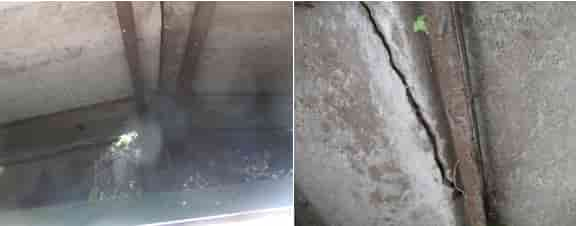Asbestos – Common Property Defects #5
Saturday, 5th March 2016
Common Property Defects | Surveying
During the course of our inspections we regularly encounter building materials which contain or may contain asbestos fibres.
Asbestos, the name of which has its origin in the Greek word ‘ásvestos’, meaning inextinguishable, is a naturally occurring rock mineral which is both fire retardant and an excellent thermal and acoustic insulator. The fibres do not dissolve in water or evaporate, and are resistant to chemical and biological degradation. Additionally, asbestos is relatively inexpensive. Due to these qualities, asbestos was used extensively in domestic buildings constructed in the post-war period through to the 1980s, and its use continued (albeit to a diminished degree) up until the turn of the 21st Century.
Asbestos fibres, if inhaled, can cause a range of lung related disorders, including cancer, resulting in severe disability and, in many cases, death.
There are six types of Asbestos; chrysotile (belonging to the serpentine mineral family), and amosite, crocidolite, anthophyllite, tremolite and actinolite (all belonging to the amphibole mineral family). Chrysotile (known as ‘white asbestos’) is the most common variety. Of the amphibole mineral family types, amosite (known as ‘brown asbestos’) and crocidolite (known as ‘blue asbestos’) were also widely used. Whist there is no ‘safe’ level of exposure to any type, those of the amphibole family are generally considered to pose the highest risk to health.
Due to the associated risks to health the import and supply of products containing brown and blue asbestos was banned under the Asbestos Prohibition Regulations 1985. Under the Asbestos Prohibition Regulations 1992 the ban was extended to all amphilbole family types of asbestos, and the limitations were placed on the use of white asbestos. It was not until the introduction of the Asbestos Prohibition (Amended) Regulations 1999 that the import, supply and use of all asbestos containing products in buildings materials was made illegal.
Asbestos is found in a wide range of older building materials. Many textured wall and ceiling coatings (generically referred to as Artex) contained white asbestos. Asbestos is present in a number of older roofing materials, including soffits, gutters, rainwater pipes, roofing boards, and a variety of synthetic slates and tiles. Due to its fire retardant properties composite panelling containing asbestos was used on fire doors and around electrical equipment and boilers. Due to its thermal insulating capacity asbestos was used in a number of older laggings, insulation boards and sprayed coatings. It can also be found in some floor coverings, such as certain linoleums and thermoplastic tiles, alongside older cement flues. Today, the use, supply, and importation of asbestos, alongside regulations and duties in respect of asbestos management, are all covered by the Control of Asbestos Regulations 2012.
In many cases it won’t be possible to confirm whether materials contain asbestos without laboratory testing. However, where it is suspected that a building component may contain asbestos, the component should be treated with some caution. Generally speaking, laggings and sprayed thermal insulation coatings alongside thermal insulation boards and fire retardant boards from between 1950 and 1985 pose the highest risk, as they are most likely to contain brown or blue fibres from the amphilbole family, and at particularly high levels. Conversely, asbestos cement products such as corrugated roof sheets, gutters, rainwater pipes, soffits, and garage ceiling linings typically have a lower asbestos content.

The thermoplastic tiles in the above (left) photograph date from the 1970s or early 1980s, and are likely to have an asbestos content. The Artex coating on the above ceiling (top-right) dates from the 1980s and again may contain asbestos. Previous crack repairs have been undertaken, and two holes have been drilled into the finish, posing a risk of the release of asbestos fibres into the air. Repair is required. As an alternative to removal, a thin layer of bonding may be applied and the ceiling skimmed.
Regard must also be had to the condition of the component. Those which are damaged, or located in an area that might make them prone to damage, and thus at risk of releasing fibres into the air, require immediate attention. Where the component is in good condition or only slightly damaged its likely to be safest to leave it in place, having an appropriately qualified person undertake any required repair. If necessary it may be possible to seal the component with a specialist treatment that either binds the fibres together or coats the component so that the fibres cannot be released. Where an asbestos containing component requires removal a licenced contractor must be used.

Both the internal lining and external covering of this roof are of asbestos cement board. Whist both components pose a lower risk while in good condition, in this instance they have begun to deteriorate. A licenced contractor will need to be employed to remove and dispose of the lining and the external corrugated cement board sheeting. This is likely to be costly.
When buying a property, particularly one constructed or refurbished during the 1950, 60s, 70s or 80s, regard must be had to the likelihood of the presence of asbestos. One of the many benefits to commissioning a pre-purchase survey is having an experienced Chartered Surveyor flag up potential risks to occupants, including the presence of deleterious materials such as those which may contain asbestos. If you are in the process of buying a property you can contact the team on 020 7471 8932 or by email. Alternatively, if you require specialist advice on asbestos management, or testing to confirm whether a suspicious component has an asbestos content, you can obtain details of specialist asbestos surveyors from the RICS website.
